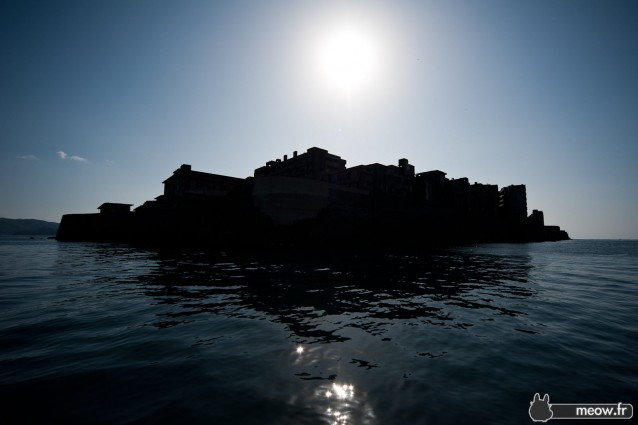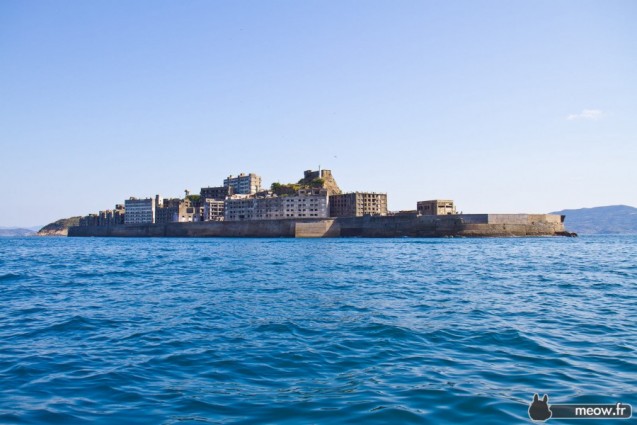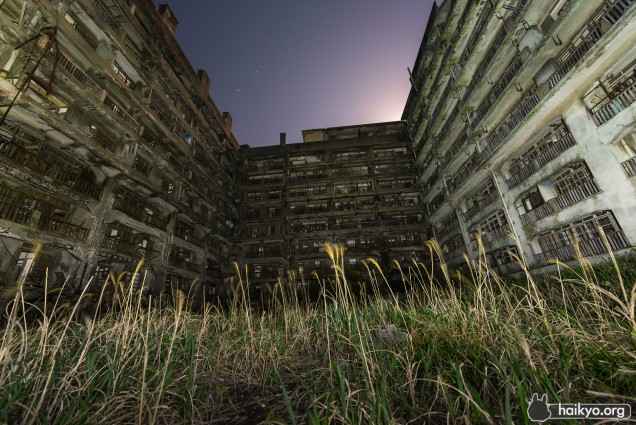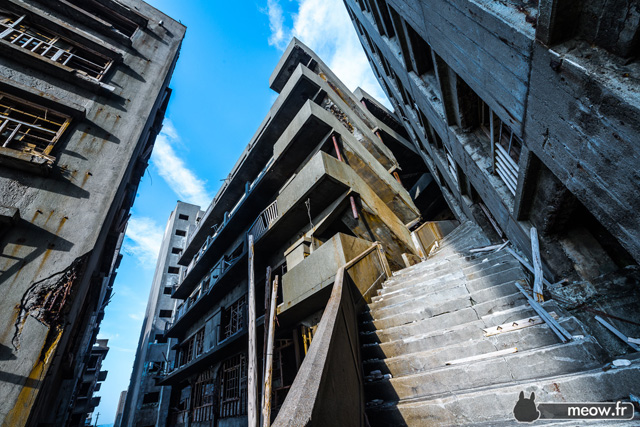Once home to a bustling coal-mining community that supported the modernization of Japan, Hashima, about 19km southwest of Nagasaki’s main port, is now better known in its ghost town state – and of course by its silhouette-inspired nickname, ‘Gunkanjima’, or ‘Battleship Island’.
by Matthew Holmes
The island fascinates not simply because it resembles a warship. It is an industrial relic left behind when the viability of coal mining plummeted in the 1970s, and what brings visitors, inspires writers and photographers and gets a certain sub-culture of hobbyists so excited, is the unique atmosphere its 1974 abandonment left behind.
Before petroleum eventually all-but killed the industry, Takashima, a larger island near Hashima, had lived off coal for centuries.
When Thomas Glover (whose name is never far from any discussion of local history in these parts) brought modern European mining techniques to the region during the Meiji period, tunneling rather than simple chipping away of surfaces became possible, and exploration of the veins of coal streaking beneath the area would result in riches.
These riches in turn funded further exploration, and when in 1887 a shaft mine was installed on Hashima, enabling under-sea mining, the island started to take on the life we see evidence of today.
Gunkanjima takes off
Things took off when the Mitsubishi company bought the Hashima mine – records show they paid ¥100,000 yen in 1890 – and began a rapid process of industrialization that brought miners and their families to live on Hashima, eventually resulting in an island-city unlike anywhere else on earth.

Approaching the silhouette of Gunkanjima (Image: © Jordy Meow/
https://offbeatjapan.org/)
The first large concrete building in Japan – an unprecedented nine-storey apartment block – was built in 1916 to accommodate workers, and slag from mining operations was gradually used to expand the area for more structures to be built inside a huge sea wall that would protect against typhoons.
In 1959, at its peak, the 16-acre site housed 5,259 people, an incredible 835 people per hectare – equivalent to 83,500/km² for the island. To put that into some kind of perspective, modern day metropolitan Tokyo has around 6,000 people per km².
Now, some 30 years since the last of those people left, visitors head to the island to try and understand the history of the place, some keen to join official tour boats that dock each day, weather permitting, some happy to circle in fishing boats and some, it is no secret, dedicated to unauthorized exploration.
Huge, imposing concrete sea walls, though now damaged, give a fortress, or even prison-like appearance to Hashima. There is virtually no vegetation on the island because of how things were constructed, and the harsh existence that would have met inhabitants of the 1.2km-round island is easy to understand.
A “Grand Haikyo”
Various hobbyists take their interest in haikyo – the abandoned buildings that litter Japan, including of course those on Hashima – rather seriously, travelling around the country after researching and following up on tips gained through community websites and from friends.
For Jordy Meow, a Frenchman living in Tokyo, haikyo are simply “a magical and exciting playground to learn about photography in a different dimension.”
The two interests lend themselves to one another, and Jordy, in collecting his atmospheric photographs on both his haikyo.org and offbeatjapan.org websites, has built up an impressive selection.

Gunkanjima with slightly more lighting (Image: © Jordy Meow/
offbeatjapan.org)
“Gunkanjima is a grand haikyo,” he tells us. “It has everything. The architecture is outstanding and the decay makes it a world wonder and its history makes it part of world heritage.”
He says he was initially hooked on haikyo because of the “diversity of places you can visit, the challenges, the research, and the travels around Japan.”
The only way to legitimately explore the island is through tourist boats that make the one-hour cruise from Nagasaki to dock and allow tourists and enthusiasts a taste of what it might have felt like to have been based in such an isolated location.
“The feeling I have when I walk on this island is amazingly difficult to express,” Jordy says. “You can actually easily imagine how life was, and what the people living there would have been doing during their lives there. It is overwhelming.”

Gunkanjima’s infamous block 65 at night (Image: © Jordy Meow/
offbeatjapan.org)
He explains that some who grew up on the island – there was a school, shops, and everything else one would expect a community to need, including a cinema and a pachinko parlor – don’t like to hear the name Gunkanjima and “consider Hashima their furusato, or hometown.”
“Miners had difficult lives, working long hours in an extremely dangerous environment, but it seems like some of the families – housewives and kids, anyway – would have enjoyed aspects of island life. We often hear about the very lively atmosphere of the Hashima-Ginza market, not far from Block 65 (the largest structure on the island) and you can imagine all the mothers on the balconies, checking on their kids who would have played downstairs in the enclosed courtyard.”
Though aspects of life will have been tough, communities would have shown relilience to occasional batterings from the weather as well as struggling through despite their isolated place in the world.
Hashima/Gunkanjima remains cluttered with decaying concrete structures that remind of the island’s industrial past and intrigue anyone who steps foot on the barren island. Taking a trip out of Nagasaki harbour, past many of the luscious green islands that scatter the sea to find out more is a must for anyone visiting the area.
All images used with permission: © Jordy Meow / https://offbeatjapan.org/
To see more of his images and read his ‘Gunkanjima Odyssey’, click the link.
Getting to Gunkanjima
Several companies offer charter boats that take visitors to the island and allows them to walk on a platform to view parts of the island (many of the photographs featured in this article are from inaccessible locations).
Yamasa Kaiun has a desk inside the Nagasaki Terminal Building from which you can arrange your tour. (1F 17-3 Motofunamachi, Nagasaki City)
For more information see: www.gunkan-jima.net or call 095-822-5002
Updated On December 26, 2022









